Although both the 2013 and 2014 GM trucks came with 5.3L V-8 engines, it’s important not to confuse the two. The 2014 Chevy Silverado trucks come with an all-new, state-of-the-art EcoTec3 5.3L that shares almost no parts with the outgoing Vortec motors. The displacement may be the same, but the engine technology most certainly isn’t. So, with that in mind, we wanted to see how much power the new 5.3L can make. This month, we’ll be starting out simple, with our friends at Stillen and the classic trifecta of intake, exhaust, and tuner. Later on, we’ll be going more in-depth, with an aggressive camshaft and other mods.
To get our hands on the first set of bolt-on upgrades, we worked with Stillen of Costa Mesa, CA and their partners Volant and DiabloSport. Volant sent us a cold-air intake kit with its new PowerCore filter technology (P/N: 155536, $358) as well as a stainless steel cat-back exhaust system (P/N: 54872, $570). DiabloSport supplied its newest Trinity T1000 tuner (P/N: T1000, $599), which features a full-color touch screen and comes preloaded with several performance tunes for this truck. Once these three components arrived Stillen, the talented techs installed our parts and checked the power gains on a dyno. Within three hours of showing up to the shop, we were ready to hit the road with more power and a throaty growl from the engine. Read on to see how these simple mods drastically improved our new Silverado’s performance and for more information about gaining performance on your new 5.3L, check out www.stillen.com.
Upon arriving at Stillen, we rolled our truck onto the dyno and did a few pulls. This gave us a baseline power output of 275 hp and 282 lb-ft of torque at the rear wheels. That’s not bad, but we knew we could do better, so we pulled into the shop and got to work.
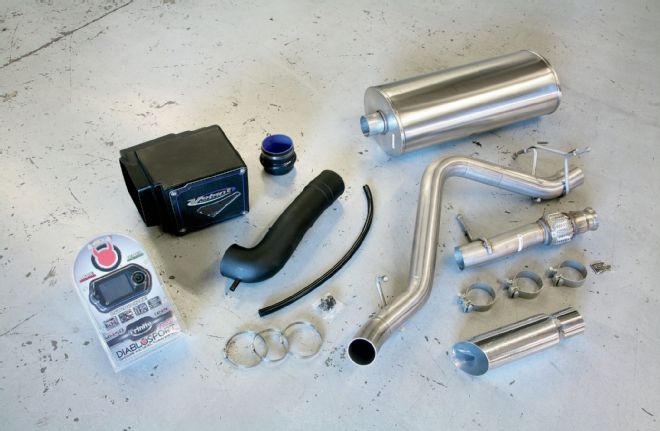
| 1.
1. First, we opened our parts boxes like kids on Christmas morning and examined what we had received. These three kits included everything we needed for a seamless install, down to the last hose clamp.
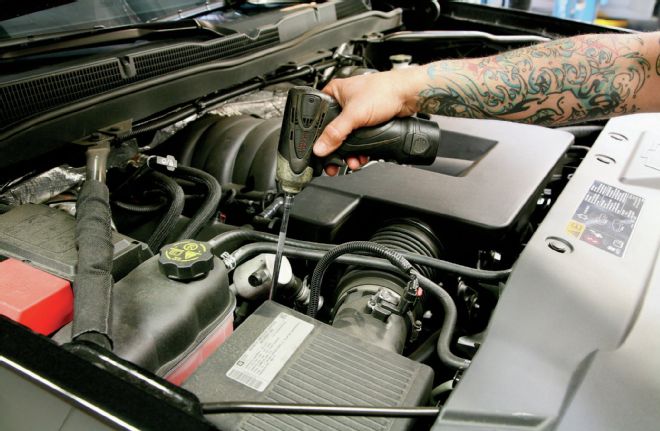
| 2.
2. Under the Chevy’s hood, four small bolts hold the stock airbox to its baseplate. They were removed, and the MAF sensor connector on the intake tube was disconnected.
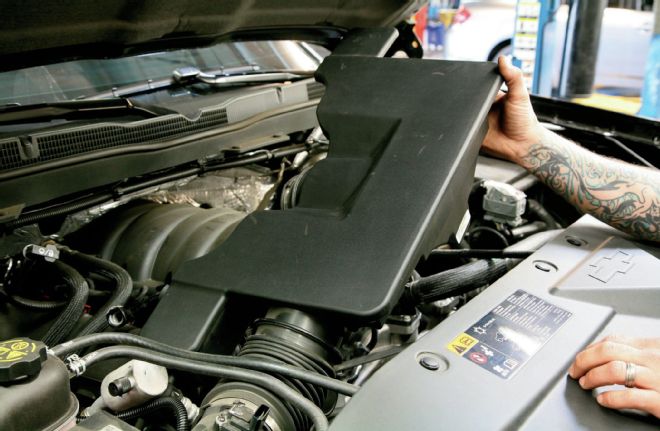
| 3.
3. Next, the intake resonator was unbolted and removed from the throttle body. Now we were able to pull out the stock intake assembly and set it aside.
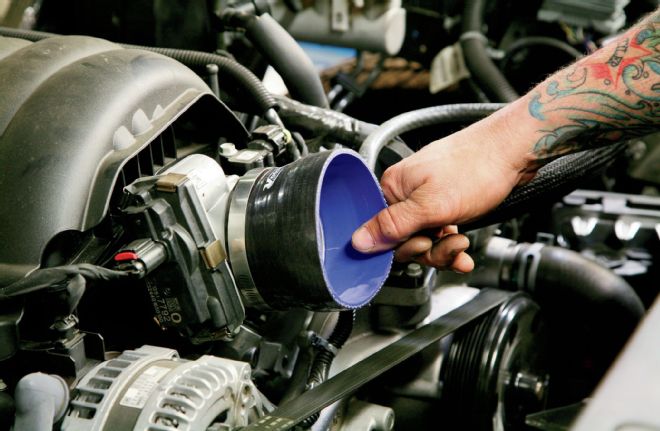
| 4.
4. Volant’s included coupler was then fitted onto the throttle body and secured with a supplied hose clamp.
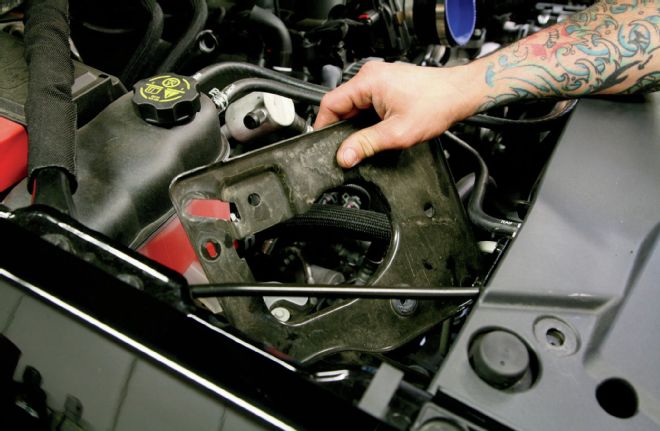
| 5.
5. To make room for the new airbox, the old airbox baseplate was unbolted and removed. We also removed the diagonal fender brace in the foreground and set it aside.
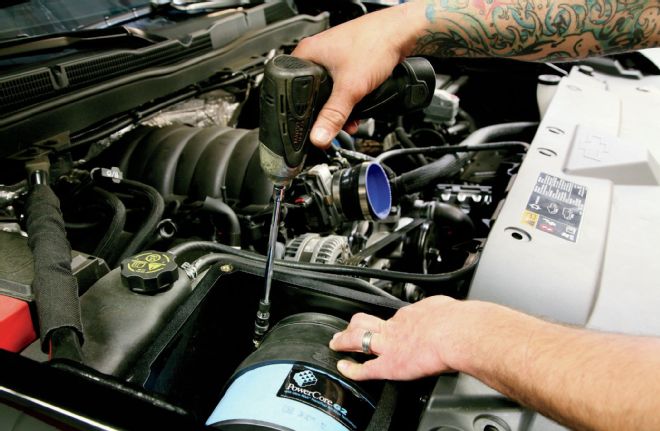
| 6.
6. The new airbox and PowerCore filter were set in place and bolted down with the supplied hardware. Then, the Volant airbox cover was screwed down atop the box.
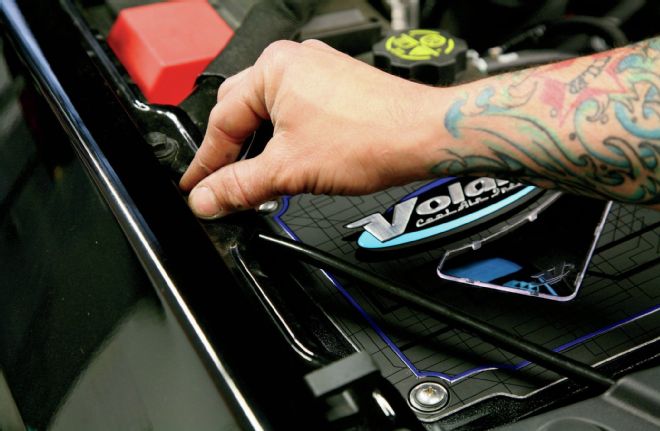
| 7.
7. With the airbox in place, we reinstalled the diagonal fender brace in its original location.
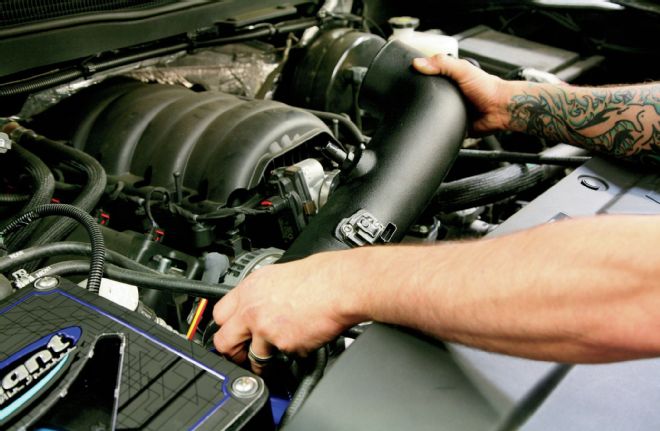
| 8.
8. The MAF sensor from the stock intake was installed on the new intake tube, and the tube was connected to the couplers on the airbox and throttle body.
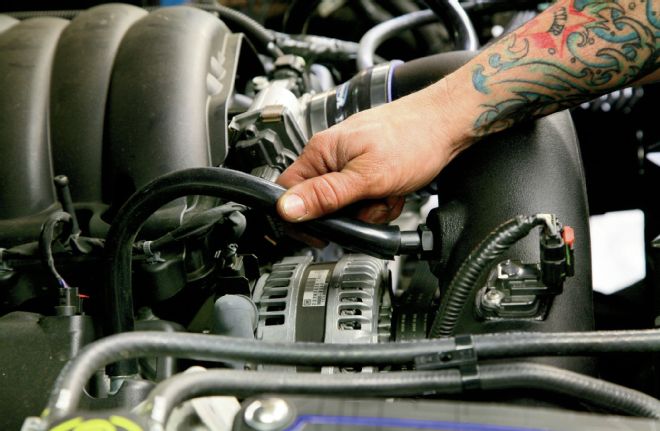
| 9.
9. Finally, this silicone tubing was used to connect the intake to the PCV valve, and the MAF sensor was plugged back into its harness.
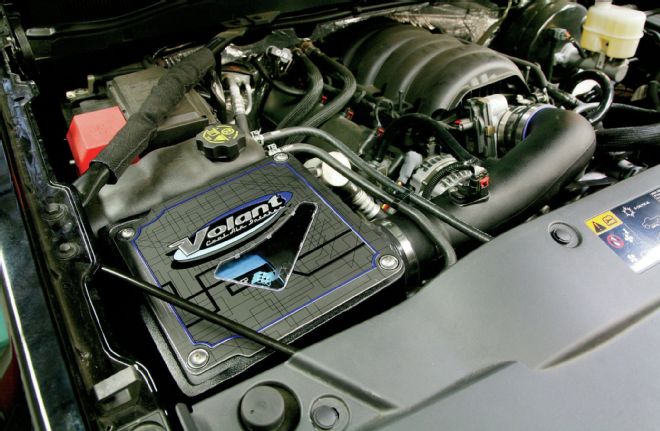
| 10.
10. The Volant intake not only looks cool, it will let us hear the engine note more clearly, and its synthetic PowerCore filtration will flow better and keep our engine healthy. Best of all, its filter warranty lasts for 4 years or 100,000 miles in urban conditions.
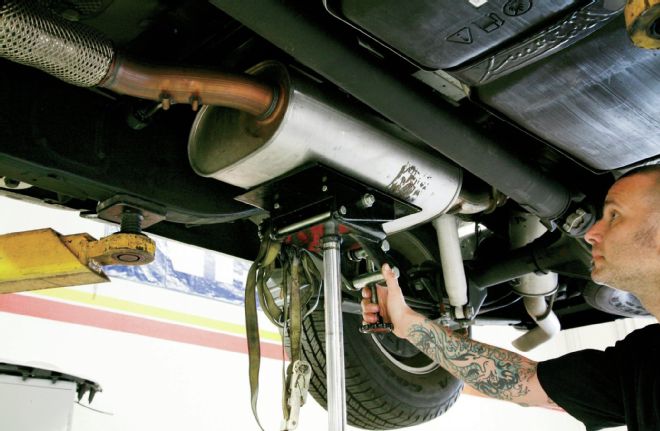
| 11.
11. With the truck up on the lift, we moved on to the exhaust system. A transmission jack was used to support the muffler while we worked.
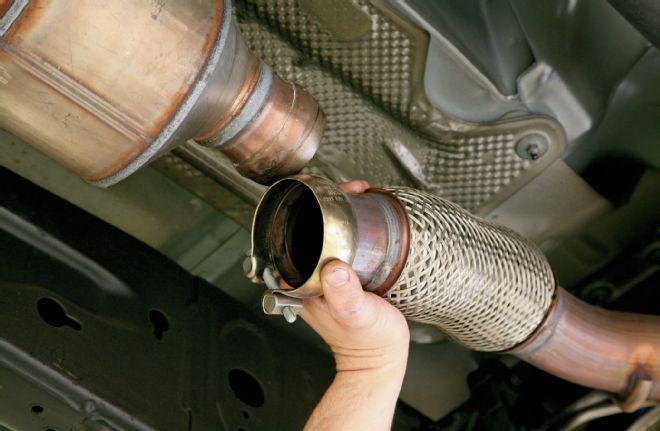
| 12.
12. The ball-flange connector mating the exhaust to the catalytic converter was disconnected first.
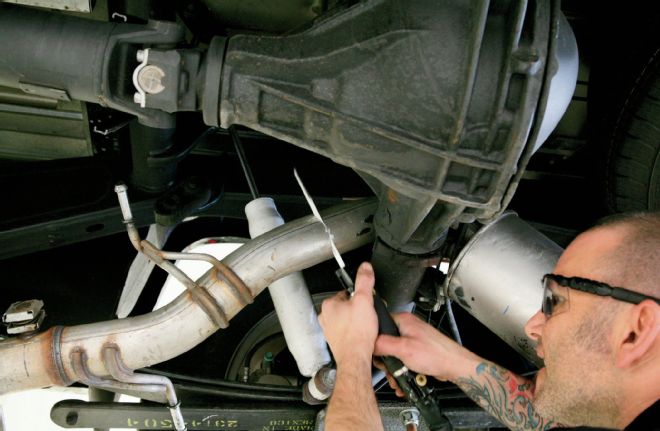
| 13.
13. After freeing the exhaust hangers from their rubber mounts, we found that the truck’s lowered suspension prevented us from maneuvering the exhaust out from over the axle. So, we simply lopped off the rear section with a sawzall.
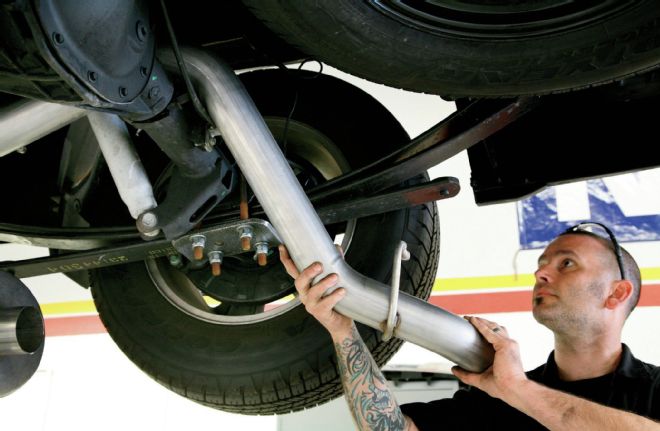
| 14.
14. With the old exhaust removed, we slid the new Volant rear piping up over the axle from the rear of the truck and slipped the hangers into their mounts.
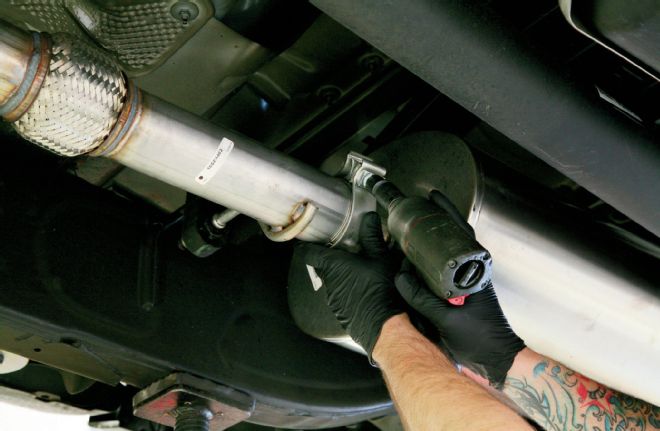
| 15.
15. The muffler and front section of pipe were lifted into place using the transmission jack, then connected to the hanger mounts and secured to the rear section.
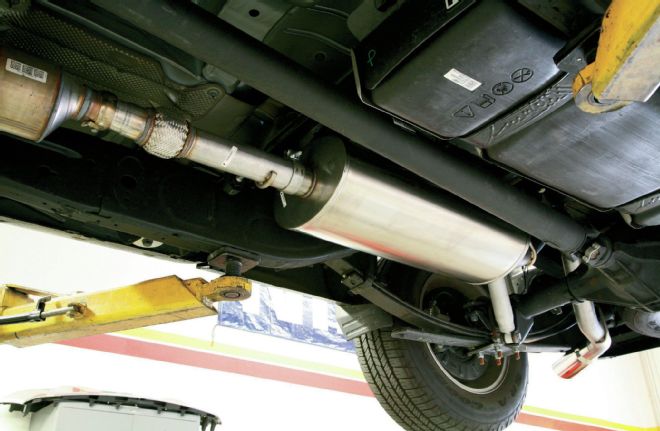
| 16.
16. The Volant system’s large muffler may look heavy, but it actually weighs much less than the stock unit. It’s also designed to filter out unwanted frequencies, for a throaty rumble and no drone.

| 17.
17. Inside the cab, the DiabloSport Trinity was attached to the windshield using the supplied mount. Its color touch screen will help us monitor engine data and performance as we drive.
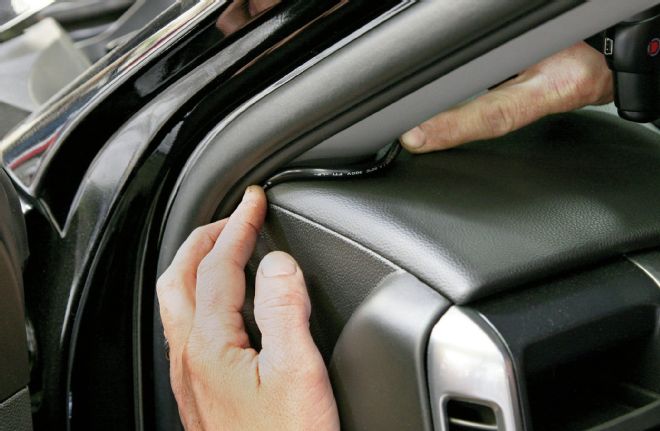
| 18.
18. The Trinity’s wiring harness was pushed down behind the dash and connected to the truck’s OBD II connector to communicate with the engine’s PCM.

| 19.
19. After turning the truck to ignition position, the on-screen instructions were followed to select our 2014 Chevy Silverado and 5.3L motor.

| 20.
20. Next, we selected the Diablo tune, which will give us maximum power output and throttle response with premium gas.
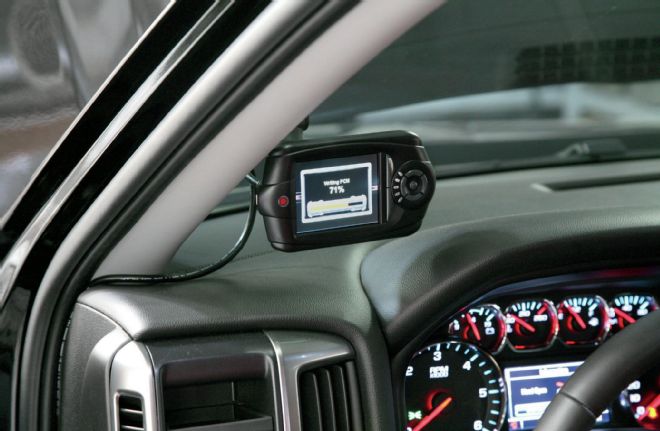
| 21.
21. With all the options selected, we watched as the Trinity made a backup of our factory setup and replaced it with the high-performance tune. Once it returned to the home screen, we were ready to fire up the truck and head back to the dyno.
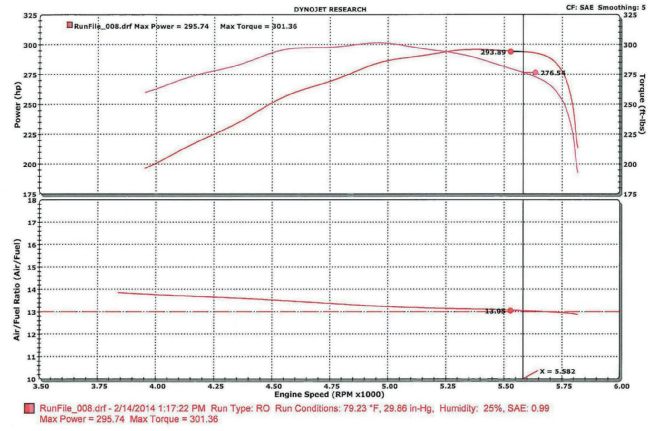
| 22.
22. Back on the Stillen dyno with the upgrades installed, our Silverado made 295 hp and 301 lb-ft of torque to the rear wheels—that’s an increase of 20 hp and 19 lb-ft from stock. The area under the horsepower and torque curves has also increased dramatically, meaning we’ll have more usable power at low rpm. After taking the truck out for a testdrive, we immediately noticed firmer shifts and improved throttle response as well. Tune in next time for even more power upgrades to this 2014 Chevy Silverado.
 | 1.
1. First, we opened our parts boxes like kids on Christmas morning and examined what we had received. These three kits included everything we needed for a seamless install, down to the last hose clamp.
| 1.
1. First, we opened our parts boxes like kids on Christmas morning and examined what we had received. These three kits included everything we needed for a seamless install, down to the last hose clamp.
 | 2.
2. Under the Chevy’s hood, four small bolts hold the stock airbox to its baseplate. They were removed, and the MAF sensor connector on the intake tube was disconnected.
| 2.
2. Under the Chevy’s hood, four small bolts hold the stock airbox to its baseplate. They were removed, and the MAF sensor connector on the intake tube was disconnected.
 | 3.
3. Next, the intake resonator was unbolted and removed from the throttle body. Now we were able to pull out the stock intake assembly and set it aside.
| 3.
3. Next, the intake resonator was unbolted and removed from the throttle body. Now we were able to pull out the stock intake assembly and set it aside.
 | 4.
4. Volant’s included coupler was then fitted onto the throttle body and secured with a supplied hose clamp.
| 4.
4. Volant’s included coupler was then fitted onto the throttle body and secured with a supplied hose clamp.
 | 5.
5. To make room for the new airbox, the old airbox baseplate was unbolted and removed. We also removed the diagonal fender brace in the foreground and set it aside.
| 5.
5. To make room for the new airbox, the old airbox baseplate was unbolted and removed. We also removed the diagonal fender brace in the foreground and set it aside.
 | 6.
6. The new airbox and PowerCore filter were set in place and bolted down with the supplied hardware. Then, the Volant airbox cover was screwed down atop the box.
| 6.
6. The new airbox and PowerCore filter were set in place and bolted down with the supplied hardware. Then, the Volant airbox cover was screwed down atop the box.
 | 7.
7. With the airbox in place, we reinstalled the diagonal fender brace in its original location.
| 7.
7. With the airbox in place, we reinstalled the diagonal fender brace in its original location.
 | 8.
8. The MAF sensor from the stock intake was installed on the new intake tube, and the tube was connected to the couplers on the airbox and throttle body.
| 8.
8. The MAF sensor from the stock intake was installed on the new intake tube, and the tube was connected to the couplers on the airbox and throttle body.
 | 9.
9. Finally, this silicone tubing was used to connect the intake to the PCV valve, and the MAF sensor was plugged back into its harness.
| 9.
9. Finally, this silicone tubing was used to connect the intake to the PCV valve, and the MAF sensor was plugged back into its harness.
 | 10.
10. The Volant intake not only looks cool, it will let us hear the engine note more clearly, and its synthetic PowerCore filtration will flow better and keep our engine healthy. Best of all, its filter warranty lasts for 4 years or 100,000 miles in urban conditions.
| 10.
10. The Volant intake not only looks cool, it will let us hear the engine note more clearly, and its synthetic PowerCore filtration will flow better and keep our engine healthy. Best of all, its filter warranty lasts for 4 years or 100,000 miles in urban conditions.
 | 11.
11. With the truck up on the lift, we moved on to the exhaust system. A transmission jack was used to support the muffler while we worked.
| 11.
11. With the truck up on the lift, we moved on to the exhaust system. A transmission jack was used to support the muffler while we worked.
 | 12.
12. The ball-flange connector mating the exhaust to the catalytic converter was disconnected first.
| 12.
12. The ball-flange connector mating the exhaust to the catalytic converter was disconnected first.
 | 13.
13. After freeing the exhaust hangers from their rubber mounts, we found that the truck’s lowered suspension prevented us from maneuvering the exhaust out from over the axle. So, we simply lopped off the rear section with a sawzall.
| 13.
13. After freeing the exhaust hangers from their rubber mounts, we found that the truck’s lowered suspension prevented us from maneuvering the exhaust out from over the axle. So, we simply lopped off the rear section with a sawzall.
 | 14.
14. With the old exhaust removed, we slid the new Volant rear piping up over the axle from the rear of the truck and slipped the hangers into their mounts.
| 14.
14. With the old exhaust removed, we slid the new Volant rear piping up over the axle from the rear of the truck and slipped the hangers into their mounts.
 | 15.
15. The muffler and front section of pipe were lifted into place using the transmission jack, then connected to the hanger mounts and secured to the rear section.
| 15.
15. The muffler and front section of pipe were lifted into place using the transmission jack, then connected to the hanger mounts and secured to the rear section.
 | 16.
16. The Volant system’s large muffler may look heavy, but it actually weighs much less than the stock unit. It’s also designed to filter out unwanted frequencies, for a throaty rumble and no drone.
| 16.
16. The Volant system’s large muffler may look heavy, but it actually weighs much less than the stock unit. It’s also designed to filter out unwanted frequencies, for a throaty rumble and no drone.
 | 17.
17. Inside the cab, the DiabloSport Trinity was attached to the windshield using the supplied mount. Its color touch screen will help us monitor engine data and performance as we drive.
| 17.
17. Inside the cab, the DiabloSport Trinity was attached to the windshield using the supplied mount. Its color touch screen will help us monitor engine data and performance as we drive.
 | 18.
18. The Trinity’s wiring harness was pushed down behind the dash and connected to the truck’s OBD II connector to communicate with the engine’s PCM.
| 18.
18. The Trinity’s wiring harness was pushed down behind the dash and connected to the truck’s OBD II connector to communicate with the engine’s PCM.
 | 19.
19. After turning the truck to ignition position, the on-screen instructions were followed to select our 2014 Chevy Silverado and 5.3L motor.
| 19.
19. After turning the truck to ignition position, the on-screen instructions were followed to select our 2014 Chevy Silverado and 5.3L motor.
 | 20.
20. Next, we selected the Diablo tune, which will give us maximum power output and throttle response with premium gas.
| 20.
20. Next, we selected the Diablo tune, which will give us maximum power output and throttle response with premium gas.
 | 21.
21. With all the options selected, we watched as the Trinity made a backup of our factory setup and replaced it with the high-performance tune. Once it returned to the home screen, we were ready to fire up the truck and head back to the dyno.
| 21.
21. With all the options selected, we watched as the Trinity made a backup of our factory setup and replaced it with the high-performance tune. Once it returned to the home screen, we were ready to fire up the truck and head back to the dyno.
 | 22.
22. Back on the Stillen dyno with the upgrades installed, our Silverado made 295 hp and 301 lb-ft of torque to the rear wheels—that’s an increase of 20 hp and 19 lb-ft from stock. The area under the horsepower and torque curves has also increased dramatically, meaning we’ll have more usable power at low rpm. After taking the truck out for a testdrive, we immediately noticed firmer shifts and improved throttle response as well. Tune in next time for even more power upgrades to this 2014 Chevy Silverado.
| 22.
22. Back on the Stillen dyno with the upgrades installed, our Silverado made 295 hp and 301 lb-ft of torque to the rear wheels—that’s an increase of 20 hp and 19 lb-ft from stock. The area under the horsepower and torque curves has also increased dramatically, meaning we’ll have more usable power at low rpm. After taking the truck out for a testdrive, we immediately noticed firmer shifts and improved throttle response as well. Tune in next time for even more power upgrades to this 2014 Chevy Silverado.